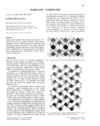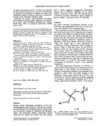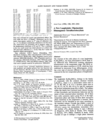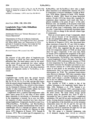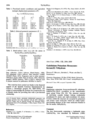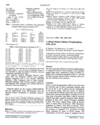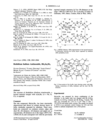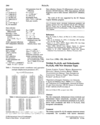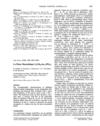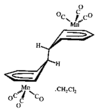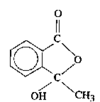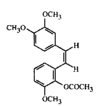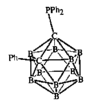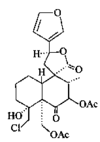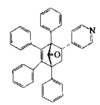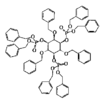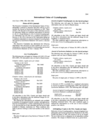issue contents
December 1996 issue

Cover illustration: A Homoleptic Cuprate(II) with Deprotonated 1,6-Anhydro-beta-D-glucose Ligands, see Gack & Klüfers, pages 2972-2975. Displacement ellipsoids are shown at the 50% probability level.
inorganic compounds
Download citation


Download citation


The structure of K2MoO2(MoO2As2O7)2 is built up from As2O7 groups and corner-sharing MoO6 octahedra to form a three- dimensional framework with intersecting tunnels where the K+ ions reside.
Download citation


Download citation


NaYP2O7 crystallizes in the non-centrosymmetric space group P21. The structure consists of corner-sharing YO6 octahedra and P2O7 groups with alternate stacking of octahedral and phosphate layers. The framework delimits intersecting tunnels where the Na+ ions are located.
Download citation


Download citation


K2Mn2(BeF4)3 has a langbeinite-type structure. Each Mn2+ cation is surrounded by six F− anions in the form of a distorted octahedron, each F− ion belonging to a different BeF42− tetrahedron. The K+ ions are nine-coordinate.
Download citation


Download citation


Tl2Cd2(SO4)3 has a langbeinite-type structure in which each Tl+ ion is surrounded by nine O atoms, forming an irregular polyhedron. Each Cd2+ ion is coordinated by six O atoms in the form of a distorted octahedron, each O atom belonging to a different sulfate ion.
Download citation


Download citation


The structure of GdKFe(CN)6.3H2O contains non-linear cyanide bridges which link octahedrally coordinated Fe atoms and eight-coordinate Gd atoms. Cavities within the structure are occupied by K+ ions and zeolitic water molecules.
Download citation


Download citation


Ca5(AsO4)3Cl crystallizes in the hexagonal system and is closely related to its phosphate analogs Ca5(PO4)3X (X = Cl, OH), but has a slightly modified structure in terms of the anion sites.
Download citation


Download citation


The structure of LiNi1.5P2O7 is composed of [P2O7] layers separated by chains of [NiO6] octahedra. The Li+ sites are six-coordinate with four short and two long Li—O bonds.
Download citation


Download citation


The structure of rubidium indium antimonide, a layered material isotypic with A2In2Sb3 (A = Na, K, Cs), is reported.
Download citation


Download citation


Fe3Al2Si3 contains three iron, two aluminium and three silicon sites whose atomic environments derive from icosahedra. Fe3Al2Si4 contains two iron, one aluminium and three silicon sites whose atomic environments derive from hexagonal cuboctahedra.
Download citation


Download citation


Li2Nb0.5In1.5(PO4)3 contains PO4 tetrahedra and distorted MO6 octahedra with a statistical distribution of Nb and In atoms over the M sites. The framework contains cavities, one of which is fully occupied by Li+ while the other two are occupied by 1/3Li+ and 2/3Li+.
metal-organic compounds
Download citation


Download citation


Download citation


Download citation


Download citation


Download citation


Download citation


Download citation


Download citation


Download citation


Download citation


Download citation


Download citation


Download citation


Download citation


Download citation


Download citation


Download citation


Download citation


Download citation


Download citation


Download citation


Download citation


Download citation


Download citation


Download citation


Download citation


Download citation


Download citation


Download citation


Download citation


Download citation


Download citation


Download citation


Download citation


Download citation


Download citation


Download citation


Download citation


Download citation


Download citation


Download citation


Download citation


Download citation


Download citation


Download citation


Download citation


Download citation


Download citation


Download citation


Download citation


Download citation


Download citation


Download citation


Download citation


Download citation


Download citation


Download citation


Download citation


Download citation


Download citation


Download citation


Download citation


Download citation


Download citation


Download citation


Download citation


Download citation


organic compounds
Download citation


Download citation


Download citation


Download citation


Download citation


Download citation


Download citation


Download citation


Download citation


Download citation


Download citation


Download citation


Download citation


Download citation


Download citation


Download citation


Download citation


Download citation


Download citation


Download citation


Download citation


Download citation


Download citation


Download citation


Download citation


Download citation


Download citation


Download citation


Download citation


Download citation


Download citation


Download citation


Download citation


Download citation


Download citation


Download citation


Download citation


Download citation


Download citation


Download citation


Download citation


Download citation


Download citation


Download citation


Download citation


Download citation


Download citation


Download citation


Download citation


Download citation


Download citation


Download citation


Download citation


Download citation


Download citation


Download citation


Download citation


Download citation


Download citation


Download citation


Download citation


Download citation


Download citation


Download citation


Download citation


Download citation


Download citation


Download citation


Download citation


Download citation


Download citation


Download citation


Download citation


Download citation


Download citation


Download citation


Download citation


Download citation


Download citation


Download citation


Download citation


Download citation


Download citation


Download citation


Download citation


Download citation


Download citation


Download citation


Download citation


Download citation


Download citation


Download citation


Download citation


Download citation


Download citation


Download citation


Download citation


Download citation


Download citation


Download citation


Download citation


Download citation


Download citation


Download citation


Download citation


Download citation


Download citation


Download citation


Download citation


Download citation


Download citation


Download citation


Download citation


Download citation


Download citation


Download citation


Download citation


Download citation


Download citation


Download citation


Download citation


Download citation


Download citation


Download citation


Download citation


Download citation


Download citation


Download citation


Download citation


Download citation


Download citation


Download citation


Download citation


Download citation


Download citation


Download citation


Download citation


Download citation


Download citation


Download citation


Download citation


Download citation


Download citation


Download citation


Download citation


Download citation


Download citation


Download citation


Download citation


Download citation


Download citation


Download citation


Download citation


Download citation


Download citation


Download citation


Download citation


Download citation


Download citation


Download citation


Download citation


Download citation


Download citation


Download citation


Download citation


Download citation


Download citation


Download citation


Download citation


Download citation


Download citation


Download citation


international union of crystallography
Free 



 journal menu
journal menu











